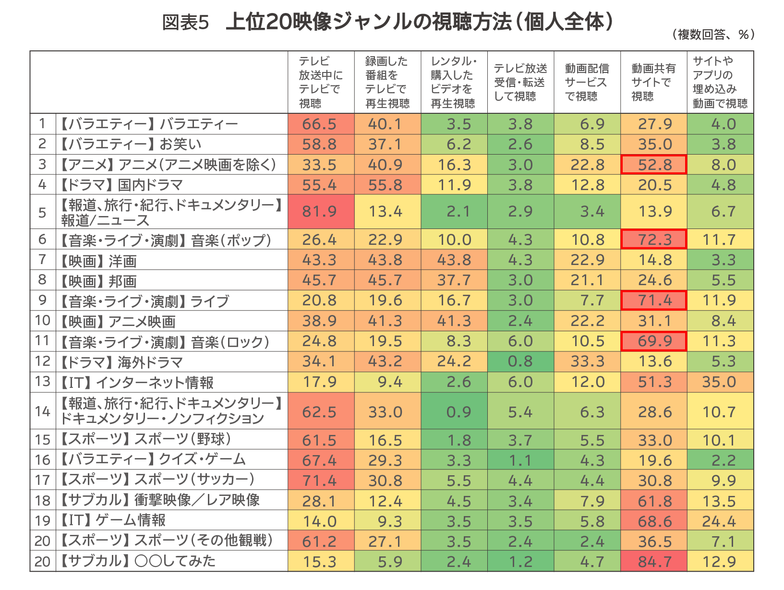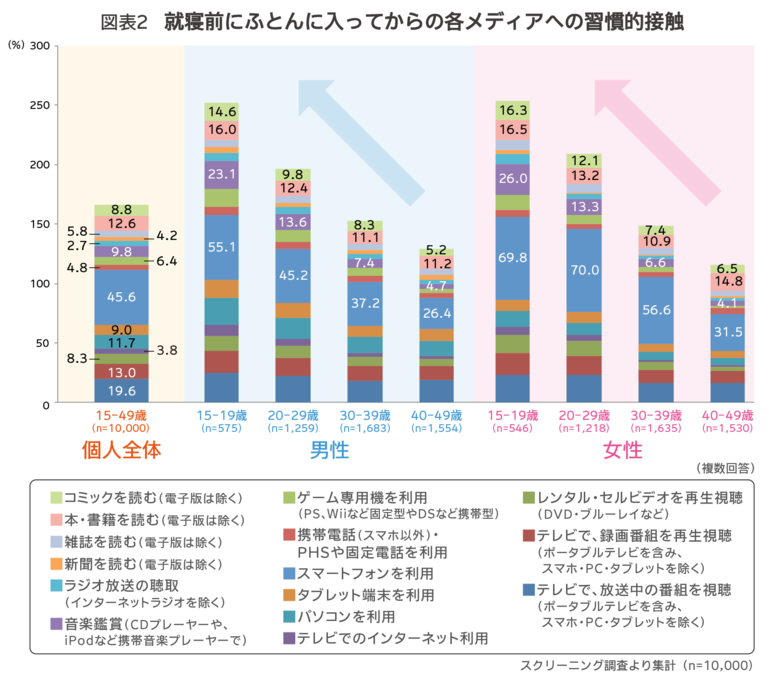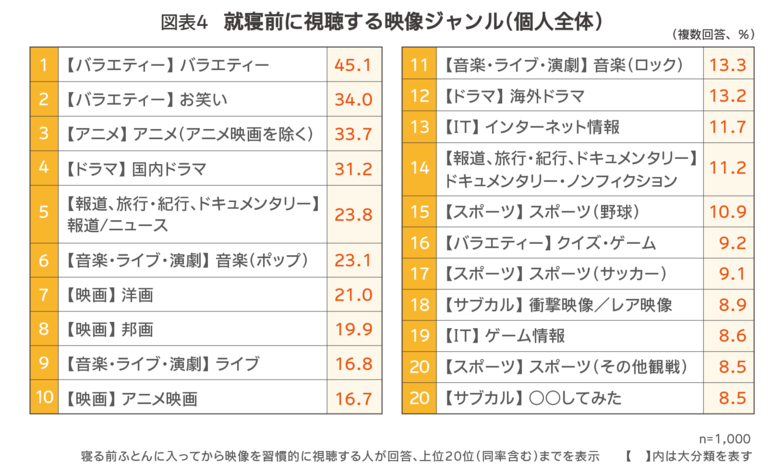■What are you watching before bed?
The Media Innovation Research Department at DENTSU SOKEN INC. continues to explore changes in media and information communication environments and the resulting audience trends. Last year, we investigated the new media consumption trend that emerged during the smartphone proliferation period: "Video Viewing During Commutes and School Runs." By examining the video genres, viewing frequency, and duration of content smartphone users watch on trains and buses, we gained insight into the smartphone usage habits of those "people next to you" who inevitably catch your attention during your commute or school run. (Reference Article: Video Viewing During Commutes and School Runs ~ What Are People Watching on Trains and Buses?~ )
This time, as a follow-up second installment, we investigated media consumption "after getting into bed before sleep." We hypothesized that just as the proliferation of smartphones and tablets dramatically changed daily commuting and school-commuting scenes, it might also be transforming media consumption scenarios at the "bedside" (pillow).
This time, we specifically focused on "video" viewing habits. Treating both TV programs and online videos as "video," we first conducted a preliminary survey. We asked 10,000 men and women aged 15 to 49 nationwide whether they had the habit of "watching video content on TV or online devices after getting into bed before sleep." Then, from those who reported having this habit, we selected 1,000 individuals and conducted a cross-sectional survey on their viewing genres and methods.
Imagine this: Wouldn't you be a little curious about what kind of video content that special someone you're interested in watches right before falling asleep?
■ "Before Bed" is Prime Time for Media Consumption
First, how many people habitually watch video content on TV or internet devices after getting into bed before sleep? The results show that 32.7% of all individuals aged 15 to 49—roughly one in three—habitually watch video content. Notably, among teens, nearly half of both males (49.6%) and females (50.0%) have this viewing habit (Figure 1).

Figure 2 shows the results of a multiple-answer question about the media and devices people typically use in bed before sleep, not limited to video content. Looking at the stacked bar graph for all surveyed individuals on the far left, the total exceeds 150%. This indicates that, on average, individuals routinely engage with over 1.5 different media or devices between getting into bed and falling asleep.
Looking at the breakdown of media contact for all individuals, "smartphone use" was cited by 45.6% of respondents, the highest percentage. This was followed by "watching live TV programs" (19.6%), "watching recorded TV programs" (13.0%), and "reading books" (12.6%). Indeed, smartphones and TV are positioned as the two major media for contact before bedtime.
Now, let's examine the same Chart 2 by gender and age group. For both genders, younger age groups are more active in most media behaviors. Looking at the breakdown, "listening to music" stands out: 23.1% of males and 26.0% of females in their teens engage in this activity, significantly outpacing those in their 20s and older.
While there's talk of younger generations "moving away from books," the results show that when confined to activities in bed, not only comics but also other "books/publications" are more habitually consumed by younger people.
■Younger people enjoy pre-sleep videos in more diverse ways
Figure 3 focuses on viewing methods for "video content" like TV programs and online videos.
Methods for watching TV programs include watching live broadcasts, watching recorded programs, receiving TV broadcasts via internet devices like smartphones or tablets, or watching programs transferred to these devices. Watching DVDs or Blu-ray discs is also, of course, a method of viewing video content.
For online video viewing, we examined two methods: viewing via video streaming services and viewing via video sharing sites.
Across all video viewing methods, younger age groups reported more habitual and frequent viewing. Notably, despite talk of younger generations "turning away from TV," when it comes to watching broadcasts live or recorded, teens and those in their 20s showed more active viewing habits than those in their 30s and 40s during the "before bed, after getting into bed" scenario.
Among these, the viewing trend showing the most significant difference by age group was "viewing on video-sharing sites." It is clear that for both genders, this is the most common habitual video viewing method among teens. Younger generations, who grew up in an information environment where the internet, particularly video sites, has always existed, have recently gained access to personal devices like smartphones and tablets. This may be driving changes in their video viewing behavior.
■ Are TV-Origin Video Genres Popular?
So, what video genres are people watching before bed? We selected 1,000 people who habitually watch some kind of video before bed and asked them to select their viewing genres from 46 categories using a multiple-answer format. Figure 4 shows the top 20 video genres listed by individuals overall.
Looking at the top entries, familiar TV program genres like "Variety Shows," "Comedy," "Anime," "Domestic Dramas," and "News/Reporting" appear.
Conversely, genres associated with "online videos" include "Internet Information" (13th), "Shocking/Rare Footage" (18th), "Game Information" (19th), and "Trying Out XX" (20th). However, none of these made it into the top 10.
This result seems to reflect a lack of visibility for the active use of video-sharing sites, particularly among younger demographics. What does this mean?
■Video-sharing sites sometimes surpass TV viewing, especially for anime and music
We asked respondents how they watch specific genres. The results are shown in Figure 5 below. For genres like "Variety Shows," "Comedy," and "Domestic Dramas," most people watch via live TV or recorded playback, which is largely as expected. Similarly, genres like "Internet Information," "Shocking/Rare Footage," "Game Information," and "Trying Out XX" are predominantly watched on video-sharing sites, which is also as expected.
However, focusing on "watching on video sharing sites," we see that for "anime" (the third most popular viewing category), "watching on video sharing sites" is the most common method, surpassing TV viewing. Similarly, for "music (pop)," "live performances," and "music (rock)," "watching on video sharing sites" also surpasses both live TV viewing and recorded playback.

Thus, for several video genres that have traditionally been watched on TV and rank within the top 10 or so, the "watching on video-sharing sites" camp now holds the majority. Furthermore, although not shown in the charts, this trend is stronger among younger demographics, regardless of gender. This is thought to be linked to the active use of video-sharing sites among teens and those in their 20s.
■ Younger Viewers Skillfully Switch Viewing Methods by Video Genre
The "after getting into bed before sleep" scenario shows extremely active media engagement across the board, making it arguably the "modern prime time" for various media.
Video viewing, whether TV programs or online videos, was particularly popular among younger generations. Even among teens, the age group most active on video-sharing sites, those who watch only one medium (TV or online video) appear to be in the minority. A pattern emerged where viewers skillfully switch between multiple viewing methods depending on the video genre. Particularly with the proliferation of internet-connected devices like smartphones, viewing scenarios outside of TV seem to be gaining prominence for certain video genres.
2015 was a year that saw numerous new video streaming services launch and gain significant attention. It will be increasingly important to keep an eye on how video viewing styles evolve from here.
[Overview of "Survey on Video Viewing Immediately Before Bedtime"]
● Screening Survey (Web-based)
Respondents: Men and women aged 15-49 nationwide
Number of Responses: 10,000
Samples collected proportionally according to national population ratios by gender and age group
Main Survey Participant Selection Criteria
Individuals who habitually watch video content (regardless of whether it's TV programs or online videos)
● Main survey (web survey)
● Main survey (web survey)
Sample size: 1,000
Proportional sampling based on gender and age group occurrence rates of those meeting the main survey participant selection criteria in the screening survey
Survey period: Friday, September 25, 2015 to Monday, September 28, 2015
Fieldwork Partner: Dentsu Macromill Insight, Inc.







